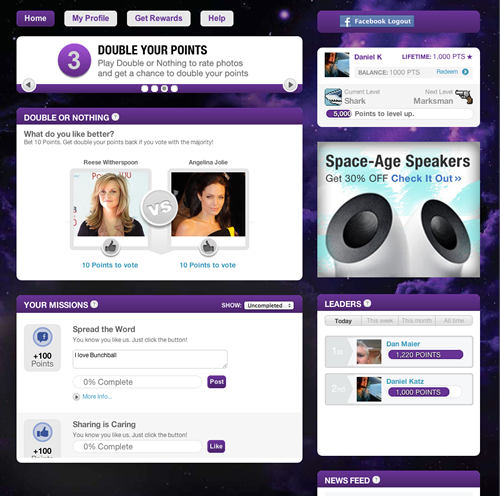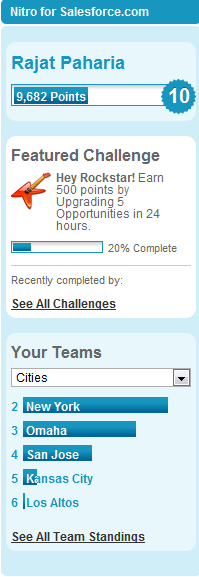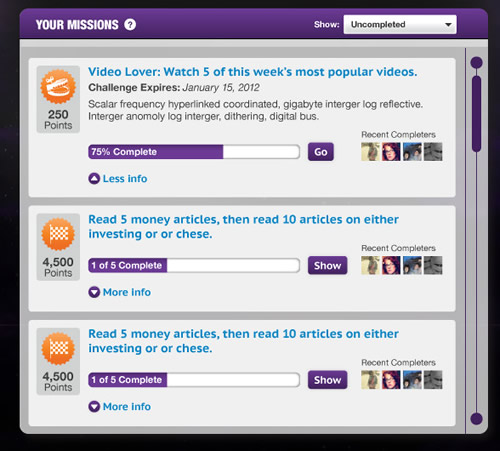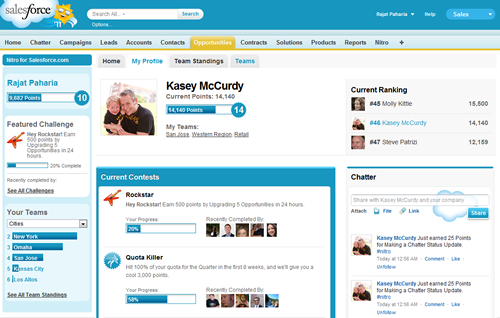Gamification
How Bunchball Uses Gamification to Motivate Your Workforce

“Gamification” is the term coined by Bunchball to describe the use of game mechanics to drive user engagement in non-game contexts. We recently sat down with Bunchball founder Rajat Paharia to talk about the origins of Bunchball, the power of motivation, and the gamification of the workplace.
You can visit the Bunchball website for more information, or read our blog post profiling Bunchball and its products.
What is gamification?
Gamification is using game mechanics—things like goal setting, real-time feedback, transparency, competition, teams, leveling up, and badges, which game designers have used for years —to drive high value activity and loyalty amongst customers, employees and partners.
Within that context, what does Bunchball do?
So we have a technology platform that does that. If you look at all those components—goal setting, feedback, transparency, statistics, competition, teams, etc.—we have a technology platform that provides all that and can be integrated seamlessly into anybody’s online experience. So our customers span that gamut from people using it on consumer-oriented sites to engage fans or community members; to companies using it with our partner networks to motivate channel partners to learn more about their products and sell more; to companies using it internally with their employees to get them to learn new pieces of software or training processes to be better at service and help-desk type activities.
So they’ve all taken our technology platform, integrated it into some online work process, or entertainment or community process, and are using it to drive behavior around that process.
When you founded Bunchball gamification was a new concept. Could you talk about founding the company and the challenges you met early on spreading the word about gamification?
So when I started this company in 2005 I started it as a social gaming company. The history of the company has been we’ve seen the future very clearly, we just haven’t had the timing right. So in 2005, we were selling social games. We were going out to all the social networking guys and pitching them on, like, people are going to get tired of collecting their friends and they’re going to want to do something with them, and we have this gaming platform that you can integrate directly on top of your social graphs that will allow people to play games either in real time or turn-based. And nobody was buying, nobody believed it. Facebook’s platform didn’t launch until mid-2007, two and a half years later. So we were a couple of years too early to that market.
Then in early 2007 as we had been building this gaming platform we realized that the really sticky gaming platforms were doing this gamification thing—though they weren’t calling it that, they were calling it a meta-game or something else—where basically they had all these individual game experiences and they were tying them together with things like badges and levels and leader boards. They got people engaged outside of the game, but it was all based off the statistics from the games that they were playing.
So we’re creating this fabric that tied all these gaming components together and we realized pretty quickly in 2007 that you could take that fabric and you could wrap it around any kind of content, community, commerce, and it would still work. These game mechanics were based on the fundamental human needs and desires that people had for reward, status, achievement, competition, self-expression, and altruism. You could take those mechanics and leverage them anywhere that you had people to motivate.

So in 2007 we switched the company from being a gaming provider to being a gamification provider. Even then we didn’t call it that. Nobody knew what to call it. We tried a bunch of names—we were calling it driving behavior, web catalytics, and then finally game mechanics. In the end we came up with this term gamification and really liked it because it implied a transformation of something. Game mechanics sounds like a thing or a person, whereas gamification implies that there’s something there that exists already that is being transformed with this process.
So we liked it and we started using the term. Gabe Zichermann and some others started using the term, and it was the term that the industry adopted, that stuck and took off. So that was great, there was a name for this thing.
In 2007 our very first customer was NBC.com for a community site for fans of the TV show The Office, called DunderMifflinInfinity.com. Again, we were early to market, it was several years before gamification finally took off. We had to be very evangelical and very educational.
It was finally 2010 when Farmville and Foursquare exploded that the gamification market took off. Then all of a sudden people had these great examples of hundreds of millions of people being motivated by game mechanics, so they could see how it applied to their consumer business or their employees. So the market took off, then more competitors entered the space, which has been great as it kind of validated the whole space, and then we’ve been continuing to evolve the business since then. So from 2007 to 2010 we were primarily in the consumer space.
What’s happened in the last year and a half or so is the bulk of our new work is coming in the employee space—motivating employees. So we’re consistently breaking new ground and pushing this into new areas to motivate people. The workplace is where we think we’ll have a gigantic impact.
You talked about providing something that addresses human needs and desires. Does behavioral analysis play a role in your product development?

We understand a lot about motivation and what drives people. Here at the company we’ve all done the reading on things like self-determination theory, and Dan Ariely, Teresa Amabile—all these people are doing research and studies on what motivates people, and what we think of are these five fundamental drivers, which are autonomy, mastery, social connectedness and relatedness, purpose, and progress. If you can build a system that makes people feel those things, then you have this ability to motivate them.
So we do a lot of understanding of that, and then combine that with whenever we go into a customer—every situation’s different. If they’re fans of the TV show Psyche, that’s a very different motivational thing, and they’re going to have different drivers than if I’m an employee of that company on the sales team. So we just need to understand the context that everybody’s working in and design something appropriate.
How is gamification changing the marketing landscape?
So we’ve done a bunch of stuff in marketing with various brand advertisers like Victoria’s Secret, Rite-Guard, and Hewlett Packard. It’s a great way—I mean, you build these campaigns and these other ways of trying to engage users, but you really don’t have any tools in your arsenal to motivate them to engage with all this great stuff that you’re building. So those customers of ours and others are using gamification to great effect to get people to engage more, to learn more.
For instance, Adobe has gamified the 30-day free trial of Photoshop. They’ve gamified the tutorial that teaches you how to learn 12 key pieces of functionality in Photoshop, like object removal and teeth whitening, etc. I mean, the 30-day free trial is a marketing effort, right—trying to get people to download it and play with it, so that hopefully at the end of the 30 days they’ll buy. They’re using gamification to get people on board and feeling the sense of mastery at this tool so that the likelihood that they will buy at the end of the 30 days is much higher. So there’s a ton of opportunities on marketing space.
Are there any specific industries that stand to benefit most from your platform, or is it broadly applicable?
Really anywhere that there are people to be motivated, you can use our platform to motivate them. That said, we have a very particular focus on the enterprise and in the workplace right now, and then in the media consumer space. Those are our two tent poles that we focus on, that we have a lot of expertise in now. We have customers in other areas like health and education, and things like that. Those areas have been a little bit slower to adopt, so we’re just not spending our energies there right now. Other companies are kind of just going everywhere they can, but we’re focusing our efforts on the workplace, and these kinds of consumer and engagement type things.
Where do you see gamification heading in five years, and how do you see Bunchball fitting into that landscape?
It’s going to become increasingly more and more important. The phrase we often use around here is: Whoever figures out motivation wins. That’s the key. Everybody’s able to create experiences, create software, create all these things, but if you can’t motivate people to utilize them then they have no value. Whoever it is that’s going to figure out the key to motivation is going to win. They’re going to win against Google, they’re going to win against Facebook, against SAP, against Oracle and against Salesforce. They’re going to beat everybody. If you can just figure out the key to motivation. That’s exactly what we’re doing.
In terms of where this is going to have the biggest impact, it’s going to be in the workplace, which is why we’re focusing all our attention there. There’s this huge opportunity to make work better for employees and for managers through smart use of data, which is exactly what we do.
What are the most exciting things happening with Bunchball right now?
We’re growing at a tremendous rate. We’re partnering and aligning with some of the major vendors in technology—we’re a Salesforce partner, we’re an IBM partner, we’re a Microsoft partner, we’re a Jive partner. A lot of these big enterprise players are realizing and understanding that this is incredibly important to their future. So it’s tremendously exciting for us to be working with all these guys.
What are some examples of Bunchball success stories?
Club Psych is one in the media space. So USA Network has a TV show called Psych. It’s got a pretty rabid fanbase, and they built essentially a digital loyalty program for the fans of the TV show, all online. You earn points by doing various activities like watching videos and sharing through the social network and you can then compete with other Psych fans to see who the biggest fan is. And you can redeem your points for merchandise from the show and things like that. They saw huge increases in all their key metrics—time on site, page views, etc.
Then they used the same technology in a trans-media campaign that they recently ran called Hashtag Killer, which was a combination of a bunch of different trans-media type things. But in the end, it got fans incredibly engaged to the point where it was just nominated for an Emmy Award. So that’s more on the marketing side.
Then Bluewolf is a company that uses us. They’re a systems integrator in the Salesforce ecosystem. They’ve got 350 consultants and they want to figure out, how do we motivate our consultants to effectively amplify our marketing team and use social media to spread the word about us, so that we have a much bigger presence out there in the world of social media, and drive more leads to our company.
So they used our platform to build a product called, Going Social, which rewards employees for going social—for Twitter, for Facebook, for LinkedIn activity, for increasing their Klout score, for getting to come read their blog, all that kind of stuff. They’ve seen gigantic increases in the amount of people coming to their website, coming to their blog, and the amount of even internal collaboration going on in Chatter using our platform.
So that’s two completely different use cases, both very successful.
Ready to compare Bunchball and other gamification platforms to find the best fit for your business? Check out our Community Forum Software resource center for gamification software recommendations and enterprise social product reviews. You’ll also have access to content written and curated by our network of experts, including industry insights, software comparisons and selection and implementation tips.








